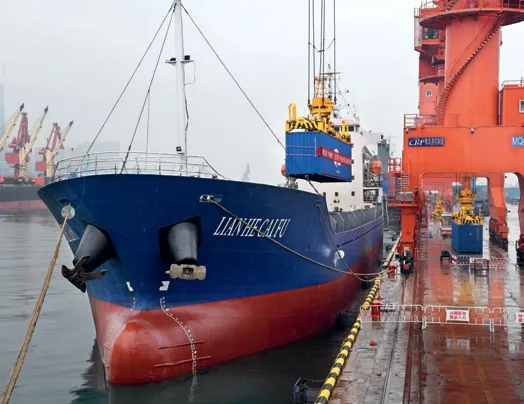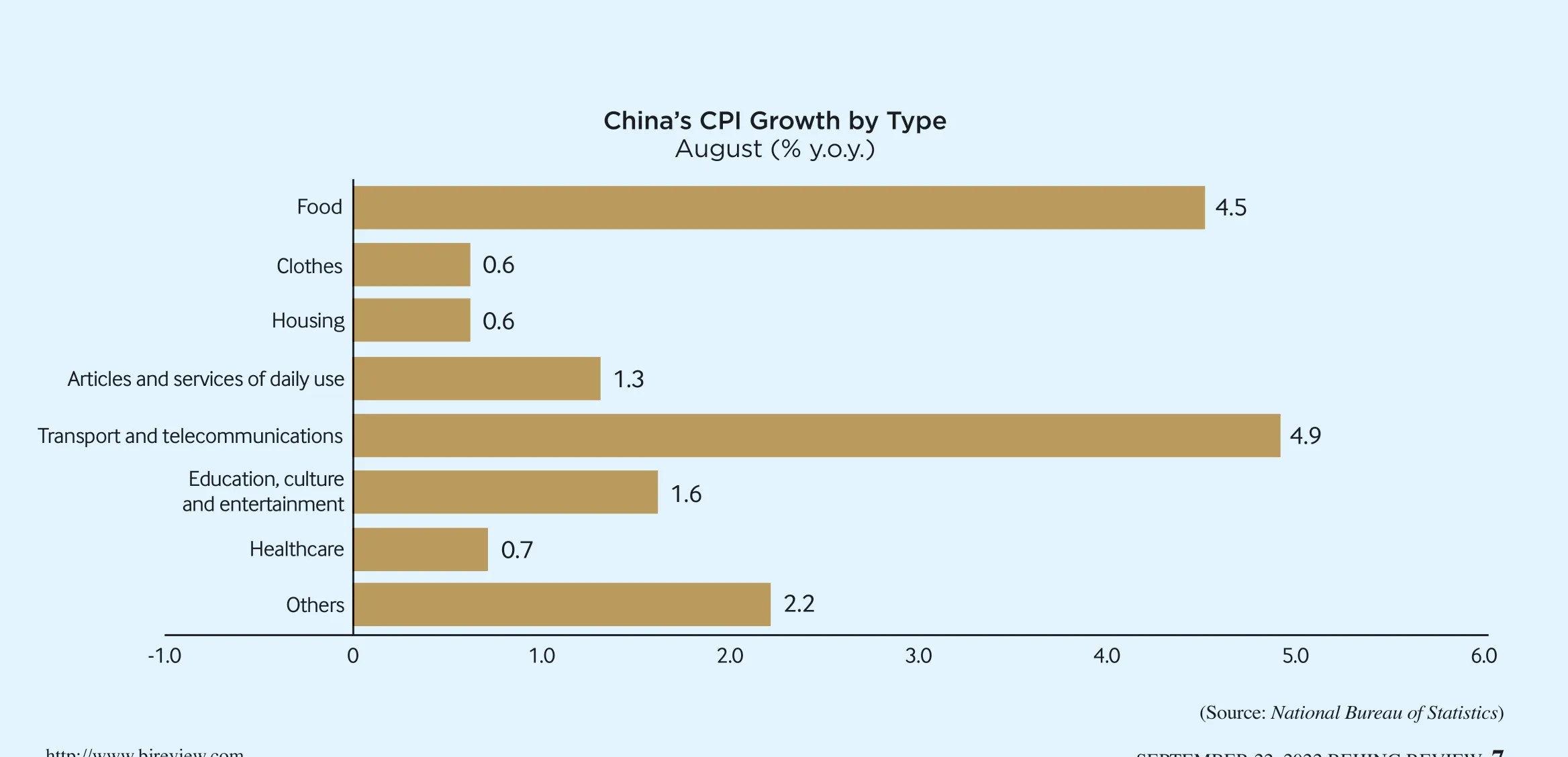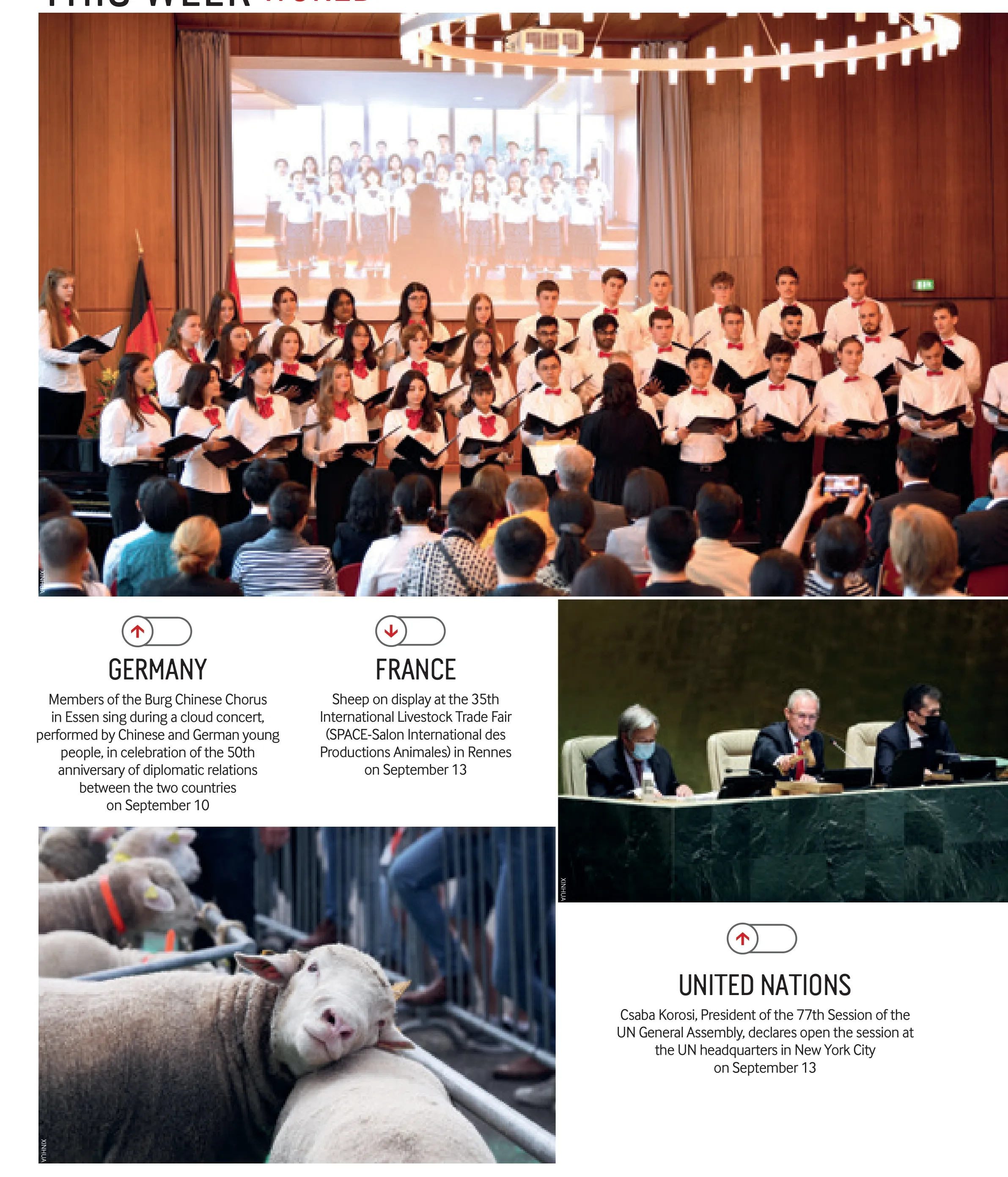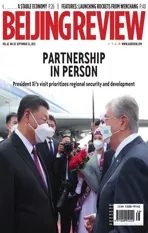THIS WEEK
2022-09-20

BON VOYAGE!
A container is hoisted onto a ship at Qingdao Port in Shandong Province on September 14. The ship, departing that day,was scheduled to arrive at the Russian port city of Vladivostok four days later.
Its voyage marked the launch of the first shipping route between the China-Shanghai Cooperation Organization Demonstration Zone for Local Economic and Trade Cooperation in Qingdao and Vladivostok. The demonstration zone operates 17 international freight train routes to 51 cities in 22 countries.
Happy Holiday
People have fun at a farm during the Mid-Autumn Festival holiday in Yantai, Shandong Province, on September 11. The three-day holiday started on September 10 this year.
Improvement to Residential Conditions
Nationwide efforts over the past 10 years have provided the Chinese people with a substantial increase in both the quantity and quality of homes, as well as improvements in urban and rural environments, coupled with the steady development of related industries.
Committed to providing everyone in China with a roof over their head, the country invested a record 14.8 trillion yuan ($2.14 trillion) in affordable housing in the past decade, helping to settle over 140 million people in new homes, Jiang Wanrong, Vice Minister of Housing and Urban-Rural Development, told a press conference on September 14.
To the same end, China has made 3.3 million affordable rental homes for young urbanites available since last year; while over 38 million low-income urban residents had moved into public rental housing by the end of 2021, said Jiang.
The housing provident fund, established in 1991 to raise money to help the country’s workforce purchase homes, has widened its coverage from 102 million people to 164 million over the decade, including over 1 million flexibly-employed people, official data shows.
Hi-Tech Zones
China has established 173 national hi-tech zones so far and will raise the number to 220 by the end of the 14th Five-Year Plan (2021-25) period, according to the Ministry of Science and Technology on September 14.
Li Youping, an official with the ministry, said at a press conference that the total output value of the national hi-tech zones grew from 5.4 trillion yuan($781.3 billion) in 2012 to 15.3 trillion yuan ($2.2 trillion) in 2021.
In 2021, the national hi-tech zones generated 13.4 percent of GDP, he added.
Over the past decade, the national hi-tech zones have made major breakthroughs in fields such as quantum information, high-speed railways, the BeiDou Navigation Satellite System, domestically produced large aircraft and 5G communications, according to the press conference.
They have also participated in a series of major national scientific and technological missions, including the development of the deep-sea manned submersible, the launch of the-spaceship and the research and development of COVID-19 vaccines.
By the end of 2025, national hi-tech zones will cover most of its prefecture-level cities in the eastern part of the country and major prefecture-level cities in the central and western parts.
Regulating Overpackaging
China will step up its regulations on overpackaging in a bid to facilitate a green shift in production and lifestyle, according to a notice released by the State Council, Xinhua News Agency reported on September 8.
A string of requirements have been set regarding production, sales, delivery and recycling to stem overpackaging, said the notice.
By 2025, overpackaging in major monitored commodities like mooncakes and tea will be under effective control, it said.
Packaging innovation will be encouraged to promote green packaging solutions, while supervision will be enhanced on e-commerce, courier and food delivery services.
Subsistence Allowance
Some 14.2 million elderly citizens in China have been brought into the country’s subsistence allowance system, an official with the Ministry of Civil Affairs said at a press conference on September 8.
Meanwhile, more than 3.7 million elderly people in the country are covered by extreme poverty aid, said Li Baojun, citing ministry statistics.
Also, nearly 37 million elderly people now enjoy old-age allowances, nursing subsidies and other types of subsidies, Li added.
These efforts ensure that the livelihoods of elderly people with difficulties can be sustained,said Li.
In terms of elderly care,the country has continued to develop community-based and at-home elderly care services to address the needs of elderly people with disabilities and those who face financial difficulties, Li noted.
He added that the care system for left-behind elderly people in rural areas has also seen development.
Tunneling Project
The construction of a largescale tunneling project under the Yangtze River kicked off on September 7 in Jiangsu Province,the China Railway Construction Corporation Ltd. said on September 8.
The project is intended to establish a major trans-river road link under the country’s longest river, connecting Nantong City with Taicang City.
With a designed maximum speed of 100 km per hour and three lanes in each direction, the expressway will be around 39 km long, including 11.2 km under the river.
The expressway is scheduled to open to traffic in 2028, and will be a hallmark project adopting sophisticated techniques of shield tunneling, water repellent and fireproofing, said Zhang Di,the chief designer.
After completion, the tunnel will help promote the integrated regional development of the Yangtze River Delta and further improve road networks in the region.
Amphibious Aircraft
China will produce a total of four prototypes of the AG600M aircraft, a full-configuration firefighting model belonging to the AG600 large amphibious aircraft family, to carry out flight test missions, its developer announced on September 10.
The second AG600M firefighting aircraft prototype completed its first flight test mission on September 10 in Zhuhai,Guangdong Province, according to the Aviation Industry Corporation of China (AVIC), the country’s leading plane-maker.
During the 22-minute flight,the aircraft performed well, and all of its systems were operating stably, AVIC said.
The aircraft will next undergo follow-up flight tests such as gathering and dropping water,which are key tasks for this amphibious firefighting aircraft.
It is expected that the third and fourth AG600M aircraft prototypes will respectively undergo their first flight tests this November and in early 2023,AVIC said.
The first AG600M prototype made its maiden flight from the ground on May 31, and its maiden flight from water on August 30.
Codenamed Kunlong,the AG600 large amphibious aircraft family is seen as key aeronautical equipment for China’s emergency-rescue system. It was developed by AVIC to meet the needs of firefighting and marine-rescue missions, as well as other critical emergencyrescue operations.
A Sight to Behold

A bird flies over a tidal bore of the Qiantang River in Hangzhou,Zhejiang Province, on September 13. The Qiantang River tidal bore,famous for its height and speed, is a traditional tourist attraction.
Bracing for Storms

Residents of Xiangshan County of Ningbo City, Zhejiang Province, take refuge in a shelter on September 14. China’s national observatory issued a red alert—the most severe warning level—that day, as typhoonwas expected to make landfall twice in the day.
Foreign-Invested Projects
Key foreign-funded projects in China are making good progress amid the country’s efforts to stabilize foreign investment,according to the Ministry of Commerce (MOFCOM).
So far, 60 percent of the projects that have started production are in full operation,while over 30 percent of the projects under construction have started production, Shu Jueting,a spokesperson for the ministry,told a press conference on September 8.
Half of the projects in their early stages have also begun construction or operation, Shu added.
In the first seven months of the year, the paid-in foreign investment of large projects, with contracted foreign investment of over $100 million each, totaled$66.85 billion, MOFCOM data showed.
The figure surged 35 percent year on year, and accounted for 53.9 percent of China’s paid-in foreign investment in the same period, according to the data.
Convenience Stores
The number of convenience stores across China exceeded 250,000 last year, with their total sales amounting to 349.2 billion yuan ($50.53 billion), according to a report released by the China Chain Store and Franchise Association.
Convenience stores have proliferated in an increasing number of cities, and stores serving local communities have become a major way for companies to expand businesses, the report said.It noted that convenience store companies attach greater importance to member customers as more than 80 percent of the stores have established a membership system and launched online businesses, but brick-and-mortar businesses remain the core source of profits.In 2021, sales of ready-toeat food increased significantly,up 7.1 percent year on year while coffee sales went up 0.8 percent,the report showed.
SME Recovery
Small and medium-sized enterprises (SMEs) continued their recovery momentum in August,as a package of government policies to stabilize the economy took effect, an industry index showed.
The Small and Medium Enterprises Development Index, calculated based on a survey of 3,000 SMEs, came in at 88.3 in the month, same as the level registered in July, the China Association of Small and Medium Enterprises said.
The index contains multiple sub-indexes to gauge the performances and expectations of SMEs.
The sub-index for the hospitality industry went up 0.3 of a point in August, marking the most significant increase among all sectors tracked. The subindex for industry went up 0.1 of a point, reversing a decline seen in July.
Bulk Commodity Market
The China Bulk Merchandise Index (CBMI), a gauge of domestic bulk commodity market growth, stood at 102.3 percent for August, up 1 percentage point compared with July, according to the China Federation of Logistics and Purchasing.
A reading above 100 percent indicates expansion and below that mark, contraction. The August CBMI reading is the highest since May 2021.
The sub-indexes for bulk commodity supply and inventory eased compared with the previous month, while the subindex for sales climbed.

The federation expected that the country’s demand for bulk commodities would rise in September as the construction off-season ends.
Auto Exports
China’s auto exports surged 65 percent year on year and reached a record high in August,data from the China Association of Automobile Manufacturers showed.
The country exported 308,000 vehicles in August, up 6.2 percent compared with one month earlier, the association said, adding that it was the first time China’s monthly auto exports had exceeded 300,000 units.
A total of 83,000 units of new-energy vehicles (NEVs) were exported in August, jumping 82.3 percent year on year and 53.6 percent month on month. NEV exports almost doubled year on year in the first eight months of this year to 340,000 units.
In the January-August period, China’s auto exports neared 1.82 million units, rising 52.8 percent from the same period of 2021, the data also showed.
Cargo Throughput
The cargo throughput via the five-tier ship locks at the Three Gorges Dam, the world’s largest hydropower project in the upper stream of the Yangtze River,reached a record high of 102 million tons during the first eight months of this year, according to the China Three Gorges Corp.
The Yangtze, an east-west inland waterway, is regarded as the country’s “golden shipping route.”
During the January-August period, nearly 24.5 million tons of key materials including coal,diesel and grain were transported via the Three Gorges Dam, up 6.3 percent year on year, according to the corporation.
The Three Gorges project is a multi-functional watercontrol system, consisting of a 2,309-meter-long and 185-meter-high dam, five-tier ship locks on the northern and southern sides, and 34 turbo-generators with a combined generating capacity of 22.5 million kW.
Since the ship locks opened to trial navigation in June 2003,the freight volume through them has increased rapidly. According to official statistics, the annual cargo throughput via the ship locks increased from 34.31 million tons in 2004 to 146 million tons in 2021.
BMW Battery Supplier
Chinese battery producer Contemporary Amperex Technology Co. Ltd. (CATL) and the BMW Group announced on September 9 a multi-year agreement to supply cylindrical battery cells to power the German carmaker’s new electric vehicle (EV)models based on its Neue Klasse platform starting from 2025.
The new cylindrical battery cells come with a standard diameter of 46 mm and will be produced at two of CATL’s future battery plants in China and Europe, each with an annual capacity of up to 20 GWh dedicated to the BMW Group.
Powered by CATL’s new cells,the sixth generation of BMW eDrive technology used in the Neue Klasse models is a major leap in EV technology, making advances in energy density,charging speed and range, according to a press release.
“The BMW Group is a special and primary partner to CATL,and we are glad to expand our strategic partnership that has been forged and strengthened over the past 11 years,” Robin Zeng, founder and Chairman of CATL, said.
“We are delighted that the BMW Group and CATL are expanding their successful cooperation. We will continue our partnership for the next generation of battery cells from 2025 onward,” Joachim Post, member of the Board of Management of BMW AG responsible for purchasing and supplier network, said.



INFECTIOUS DISEASE EXPERT TO DONATE BODY
Zhang Dingyu, Deputy Director of the Health Commission of Hubei Province, announced recently that he will donate his body for amyotrophic lateral sclerosis (ALS)research.
Zhang was born in Wuhan, Hubei Province, in 1963. In 1981, he was admitted to the Medical Department of Tongji Medical College, Huazhong University of Science and Technology, and has been working in medicine for more than 30 years.
In 2018, he was diagnosed with ALS, but it didn’t stop him from working to fight against the COVID-19 pandemic as an expert in infectious disease prevention. In early 2020, he headed the Wuhan Jinyintan Hospital in helping numerous patients infected with the novel coronavirus disease.
In 2020, Zhang became one of the recipients of the national honorary title—People’s Hero—for his outstanding contributions to the country’s fight against the pandemic.

A mooncake is a small Chinese pastry baked with varying designs and fillings, traditionally a special treat during the Mid-Autumn Festival (on September 10 this year). The holiday is about lunar appreciation and family reunion and the little cakes are regarded as a delicacy during the festivities.
But over time, the baked goods have evolved from snacks into holiday gifts.When the purpose of buying mooncakes is to present them as gifts, can and will people really consume this huge amount of the delicacies? Every year, China sees mountains of Mid-Autumn waste, including millions of unwanted mooncakes and tons of nonrecyclable packaging.
To reduce the excess, the key is to produce more flavors and create better business models. If they actually taste good, will so many little cakes still end up in the trashcan?
There are a few successful examples of mooncakes that sell well all year round. They may not come in extravagant packaging and subsequently have only small profit margins,but a durable business is much better than a flash in the oven.
“Only by seeking common,comprehensive, cooperative, and sustainable security can there be long-term stability and security in Europe and the rest of the world.”
Geng Shuang, China’s deputy permanent representative to the UN, at a UN Security Council meeting on Ukraine on September 8
“What I appreciate is the willingness of the Chinese Government to listen to our ideas and thoughts, and it incorporates them in the formulation of new policies.”
Harley Seyedin, President of the American Chamber of Commerce in South China, in a recent interview with Xinhua News Agency

Thanks to national and local policies to stabilize growth and promote consumption, China’s domestic consumer market is seeing positive changes. The production and supply chain is quickly recovering, ports and piers are buzzing with freighters, trucks are zooming across expressways and urban business centers are teeming with visitors.
According to the National Bureau of Statistics, total retail sales of consumer goods for July hit 3.59 trillion yuan ($515.3 billion),up 2.7 percent year on year. Online retail is maintaining a steady growth pace, and the performance of brick-and-mortar stores is also on the up.
Sound development in the first half of the year has injected vitality into the country’s economic growth for the second half of the year.
To stabilize the economy, the key is to sustain consumption. With external uncertainties on the rise, the major task in the upcoming months is to spur the recovery of consumption and make it the driving force for economic growth.
While the capability and confidence in consumption among groups at different income levels should be further bolstered through creating jobs and increasing incomes,it’s necessary to diversify supplies and improve the overall shopping environment.
China is leading the world in terms of cross-border commerce, online retail and mobile payments. With combined measures and policies tailored to different sectors and industries, the Chinese economy is set to welcome a brighter future.
The UN projects that there will be 366 million aging adults in China by 2050, with the working-age population to fall 23 percent.
The population aged 60 and above was 267.36 million last year, accounting for 18.9 percent of the total, with 190 million of them suffering from chronic diseases.In a rapidly greying China, cities now have to get creative to fill a massive gap in social care.
A combination of physically demanding duties, low wages and a low social status have driven many senior caregivers to leave this service sector. To retain existing staff and attract newcomers, standard income in the sector will have to go up.
Another solution would be for vocational schools to create relevant courses so that professional caregivers, eligible for higher wages, will enter the sector. The relevant authorities and local governments should also design better policies to ease the difficulties facing this sector.
NEW HEAD OF BEIJING PEOPLE’S ART THEATER
Feng Yuanzheng has become the new president of the Beijing People’s Art Theater (BPAT), a leading national theater established in 1952.
Born in Beijing in 1962, Feng was enrolled in the BPAT as a student at the age of 22. In his nearly 40-year career, he has starred in nearly 100 plays, movies and TV series.
One of this best known performances was in the 2001 TV series, in which he played one of the best-known villains in the history of Chinese TV, a surgeon who abuses his wife. It is generally accepted that the series contributed to the passing of China’s Anti-Domestic Violence Law in 2015.
Feng is the fifth BPAT president, and the first BPAT president who is also a professional actor.

“There is a saying here that there is a long queue outside the door of the Shanghai Cooperation Organization(SCO), and I think this metaphor is not exaggerated.”
Zhang Ming, Secretary General of the SCO, in a recent interview with CGTN
“China’s transformation is a phenomenon. The digital economy is growing very fast in this country.”
Teshome Toga, the Ethiopian Ambassador to China,speaking highly of China’s development in the past 10 years, especially in poverty elimination and industrial transformation, in a recent interview with
